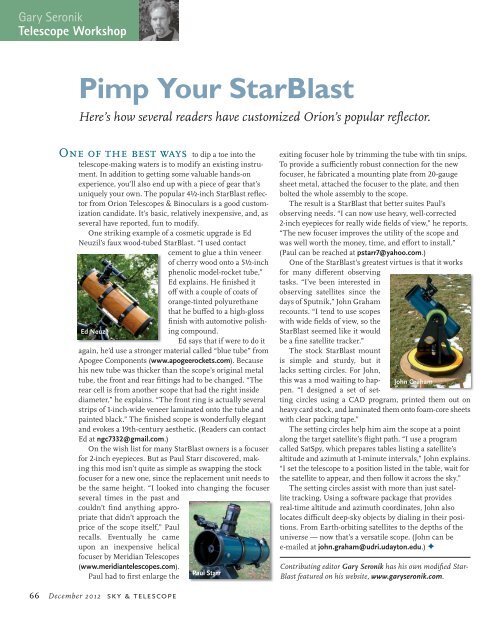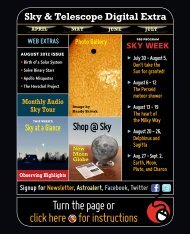Sky & Telescope Magazine December 2012 - TuLaTri.com
Sky & Telescope Magazine December 2012 - TuLaTri.com
Sky & Telescope Magazine December 2012 - TuLaTri.com
Create successful ePaper yourself
Turn your PDF publications into a flip-book with our unique Google optimized e-Paper software.
Gary Seronik<br />
<strong>Telescope</strong> Workshop<br />
Pimp Your StarBlast<br />
Here’s how several readers have customized Orion’s popular refl ector.<br />
One of the best ways<br />
to dip a toe into the<br />
telescope-making waters is to modify an existing instrument.<br />
In addition to getting some valuable hands-on<br />
experience, you’ll also end up with a piece of gear that’s<br />
uniquely your own. The popular 4½-inch StarBlast refl ector<br />
from Orion <strong>Telescope</strong>s & Binoculars is a good customization<br />
candidate. It’s basic, relatively inexpensive, and, as<br />
several have reported, fun to modify.<br />
One striking example of a cosmetic upgrade is Ed<br />
Neuzil’s faux wood-tubed StarBlast. “I used contact<br />
cement to glue a thin veneer<br />
of cherry wood onto a 5½-inch<br />
phenolic model-rocket tube,”<br />
Ed explains. He fi nished it<br />
off with a couple of coats of<br />
orange-tinted polyurethane<br />
that he buff ed to a high-gloss<br />
fi nish with automotive polish-<br />
Ed Neuzil<br />
ing <strong>com</strong>pound.<br />
Ed says that if were to do it<br />
again, he’d use a stronger material called “blue tube” from<br />
Apogee Components (www.apogeerockets.<strong>com</strong>). Because<br />
his new tube was thicker than the scope’s original metal<br />
tube, the front and rear fi ttings had to be changed. “The<br />
rear cell is from another scope that had the right inside<br />
diameter,” he explains. “The front ring is actually several<br />
strips of 1-inch-wide veneer laminated onto the tube and<br />
painted black.” The fi nished scope is wonderfully elegant<br />
and evokes a 19th-century aesthetic. (Readers can contact<br />
Ed at ngc7332@gmail.<strong>com</strong>.)<br />
On the wish list for many StarBlast owners is a focuser<br />
for 2-inch eyepieces. But as Paul Starr discovered, making<br />
this mod isn’t quite as simple as swapping the stock<br />
focuser for a new one, since the replacement unit needs to<br />
be the same height. “I looked into changing the focuser<br />
several times in the past and<br />
couldn’t fi nd anything appropriate<br />
that didn’t approach the<br />
price of the scope itself,” Paul<br />
recalls. Eventually he came<br />
upon an inexpensive helical<br />
focuser by Meridian <strong>Telescope</strong>s<br />
(www.meridiantelescopes.<strong>com</strong>).<br />
Paul Starr<br />
Paul had to fi rst enlarge the<br />
66 <strong>December</strong> <strong>2012</strong> sky & telescope<br />
exiting focuser hole by trimming the tube with tin snips.<br />
To provide a suffi ciently robust connection for the new<br />
focuser, he fabricated a mounting plate from 20-gauge<br />
sheet metal, attached the focuser to the plate, and then<br />
bolted the whole assembly to the scope.<br />
The result is a StarBlast that better suites Paul’s<br />
observing needs. “I can now use heavy, well-corrected<br />
2-inch eyepieces for really wide fi elds of view,” he reports.<br />
“The new focuser improves the utility of the scope and<br />
was well worth the money, time, and eff ort to install.”<br />
(Paul can be reached at pstarr7@yahoo.<strong>com</strong>.)<br />
One of the StarBlast’s greatest virtues is that it works<br />
for many diff erent observing<br />
tasks. “I’ve been interested in<br />
observing satellites since the<br />
days of Sputnik,” John Graham<br />
recounts. “I tend to use scopes<br />
with wide fi elds of view, so the<br />
StarBlast seemed like it would<br />
be a fi ne satellite tracker.”<br />
The stock StarBlast mount<br />
is simple and sturdy, but it<br />
lacks setting circles. For John,<br />
this was a mod waiting to hap- John Graham<br />
pen. “I designed a set of setting<br />
circles using a CAD program, printed them out on<br />
heavy card stock, and laminated them onto foam-core sheets<br />
with clear packing tape.”<br />
The setting circles help him aim the scope at a point<br />
along the target satellite’s fl ight path. “I use a program<br />
called SatSpy, which prepares tables listing a satellite’s<br />
altitude and azimuth at 1-minute intervals,” John explains.<br />
“I set the telescope to a position listed in the table, wait for<br />
the satellite to appear, and then follow it across the sky.”<br />
The setting circles assist with more than just satellite<br />
tracking. Using a software package that provides<br />
real-time altitude and azimuth coordinates, John also<br />
locates diffi cult deep-sky objects by dialing in their positions.<br />
From Earth-orbiting satellites to the depths of the<br />
universe — now that’s a versatile scope. (John can be<br />
e-mailed at john.graham@udri.udayton.edu.) ✦<br />
Contributing editor Gary Seronik has his own modifi ed Star-<br />
Blast featured on his website, www.garyseronik.<strong>com</strong>.



